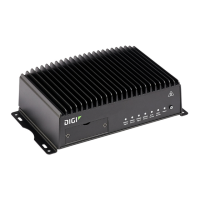Hotspot Customize the hotspot login page
Digi TransPort WR Routers User Guide
138
subfolders can be created as needed. Supported file extensions include: .html, .gif, .js, .jpg, .mp4, .ogv,
.png, .swf, .json, and .dat.
You can configure the TransPort device to use your custom HTML page using either the Web UI or the
command line:
Web
1. Upload your custom HTML file to the TransPort device's filesystem:
a. On the menu, click System > Administration > File System. The File System page
appears.
b. Expand the /hotspot directory.
Note The /hotspot directory is only available after hotspot has been enabled for
the first time.
c. Click (upload).
d. Use the local file system to browse to the location of the edited HTMLfile. Select
the file and click Open to upload the file.
2. Configure the hotspot to use your custom HTML file:
a. On the menu, click Network > Services > Hotspot.
b. Ensure that Login is set to Local Page.
c. For Local Page, select your custom HTML file.
d. Click Apply.
Command line
1. Upload your custom HTML file to the TransPort device's filesystem.
You can upload your custom HTML file using utilities such as Secure Copy (SCP), SSH File
Transfer Protocol (SFTP), or an SFTP application, such as FileZilla. For example, to upload your
custom html file by using SCP:
scp custom.html username@device_ip_address:\hotspot\custom.html
2. Configure the hotspot to use your custom HTML file:
a. Set login to local-page:
digi.router> hotspot login local-page
b. Set local-page to your custom HTML file:
digi.router> hotspot local-page custom.html
c. Save the configuration:
digi.router> save config
Restore hotspot default sample pages
If you have customized the sample HTML pages without making a backup of the samples, you may
wish to restore the original version of the HTML pages without doing a factory reset.

